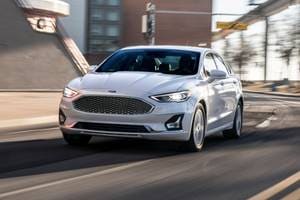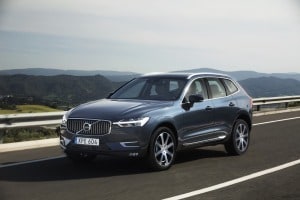Strong Economic Conditions Give Car Shoppers the Green Light to Splurge, Says Edmunds.com
DETROIT, Mich. — June 15, 2015 — Car shoppers' revived interest in more expensive vehicles, especially trucks and SUVs, likely won't end any time soon, according to the latest U.S. market analysis from car-buying platform Edmunds.com. The reason, says Edmunds, is that positive economic trends such as lower unemployment, higher confidence in the economy, and lower gas prices are encouraging shoppers to seek out bigger and more expensive vehicles.
"The cost-conscious, fuel-efficient mentality from the recession and early recovery years has faded," said Edmunds.com Chief Economist Dr. Lacey Plache, PhD, who shared her latest findings at a presentation to media in Detroit today. "We expect these economic trends to continue into next year at least, so there's every reason to believe that shopper preferences for larger and more expensive vehicles will continue along the same path that we've seen emerge in the past year or so."
Dr. Plache's team recently looked at the three most-shopped vehicle segments, comparing the sticker prices of vehicles sold in the past two years with the sticker prices of new vehicles configured by consumers on Edmunds.com during that period. In all three segments, the prices of configured vehicles increased relative to transaction prices:
- In January 2013, the average price of a configured midsize car was approximately $28,300. By January 2015, that average rose to $29,800 while the average transaction price in this segment went up from $29,100 to $29,500 in the same period.
- In January 2013, the average price of a configured compact crossover was approximately $28,000. By January 2015, that average rose to $28,900 while the average transaction price in this segment went up from $27,600 to $28,400.
- In January 2013, the average price of a configured compact car was approximately $22,300. By January 2015, that average rose to $23,200 while the average transaction price in this segment went up from $21,500 to $21,900.
"In each of the three top segments, the share of shoppers configuring higher-end, better equipped vehicles has increased while the share configuring lower-end vehicles has decreased. These changes are much greater than price band shifts due to MSRP updates would be," noted Dr. Plache, as she offered the reminder that configuration trends inform sales trends.
The upgrading of the new vehicle market is also obvious when you consider that trucks and SUVs have outsold cars in each of the last 21 months, despite significant average price differences between those segments. In May, for example, the average transaction price for trucks and SUVs was nearly $37,000, while the average transaction price for cars was about $27,400. Most shoppers are not only more attracted to those bigger vehicles, but they are paying on average $9,500 more to own one.
Two of the biggest factors that are making it easier for shoppers to afford more expensive vehicles are cheaper credit and the gravitation toward leasing. Last month, 9.5 percent of buyers who financed a new vehicle got a zero percent loan – the highest percentage since last September. And over 28 percent of new cars and trucks sold so far in 2015 were leased, putting the year on pace for the auto industry's highest lease penetration rate ever. In May, the average monthly payment for leased vehicles was $420, compared to $490 for financed vehicles.
Interestingly, these trends are not currently resulting in growth of the market share of the luxury vehicles. Shopper consideration of most luxury vehicle segments has been flat from 2013 to 2015; midrange luxury vehicle consideration has actually dipped a bit. Only the entry luxury SUV segment has shown gains in consideration during this period.
"Today's car shoppers are taking a step or two beyond the more financially conservative choices made in recent years, but we aren't generally seeing the mainstream buyer's reach into luxury the way we did before the economic crisis," stated Dr. Plache. "That was a time when many aspirational shoppers stretched their finances to get a high-status nameplate, now they are instead buying mainstream vehicles with tech options and creature comforts that allow them to spoil themselves just a little."
That said, shoppers of luxury vehicles are gravitating toward higher-end vehicles just as mainstream buyers have been doing. Compared with 2013, there is now a smaller proportion of configurations of luxury cars costing under $42,000 and fewer shares of configurations of luxury cars above that price point. Even more dramatically, there are now fewer shares of configurations of luxury SUVs costing under $47,000 and more shares of configurations above that price point.
Learn more about how American car shoppers are thinking big in a rejuvenated economic environment at http://www.edmunds.com/industry-center/analysis/what-car-shoppers-want-now.html.
About Edmunds.com
Car-shopping website Edmunds serves nearly 18 million visitors each month. With Edmunds.com Price Promise®, shoppers can get an instant, upfront price for cars and trucks currently for sale at 10,000 dealer franchises across the U.S. Shoppers can browse not only dealer inventory, but also vehicle reviews, shopping tips, photos, videos and feature stories on both Edmunds' wired site and on its acclaimed mobile apps. Regarded as one of the best places to work in Southern California, Edmunds.com was also named one of "The World's Top 10 Most Innovative Companies of 2015 in Automotive" by Fast Company. Edmunds welcomes all car-shopping questions at our Help Center and on Twitter and Facebook. The company is based in Santa Monica, Calif. and has a satellite office in downtown Detroit, Mich., but you can find Edmunds from anywhere on YouTube, Pinterest, LinkedIn, Instagram, Google+ and Flipboard.








